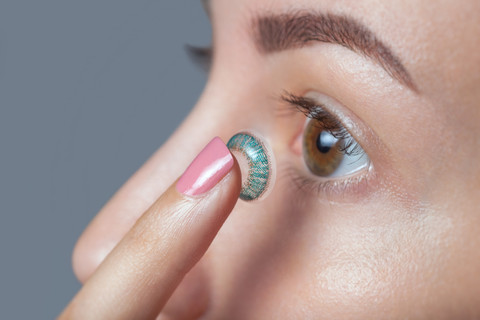Have you ever wanted to change the color of your eyes? Colored contact lenses allow you to do just that in subtle or dramatic ways. They are also known as theatrical, dramatic, decorative, costume, or Halloween lenses, as they mimic the iris – the colored part of the eye to provide a transforming look.
Colored contact lenses are another type of contact lenses and are medical devices like their non-colored alternatives, so it is essential to use them with the same care as a regular contact lens. The FDA regulates their use, and you require a prescription to get colored contacts legally.
Color contacts are not only decorative contact lenses. Prescription colored contacts are also used in correcting common refractive errors, including myopia, hyperopia, and astigmatism.
Non-prescription colored contacts only change eye color. They have no lens power to correct refractive errors but are medical devices and require a prescription and professional fitting.
This guide will help you understand colored contacts, the available types, how they work, and how you can use them safely for medical or non-medical purposes.
What Are Colored Contacts?
Colored contacts are disposable lenses designed to temporarily change the appearance of the eyes or provide vision correction. They come in many designs and colors, and they could give a natural look or dramatically switch up your look.
Colored contacts are medical devices and need a prescription to purchase. An eye doctor should give you an eye exam and prescribe you contacts that fit your eyes before using colored contacts, even if they are non-corrective.
Colored contacts have a clear center so wearers can see through them. There are three shades of tints on colored contacts:
Visibility Tint
Visibility tints are generally light blue or green added to the lens so wearers can see them during insertion and removal. They are very faint and do not affect eye color.
Enhancement Tint
Enhancement tints are darker and enhance the natural color of the eyes. They are solid, translucent and perfect for people with light-colored eyes who want to accentuate their eye color.
Opaque Tints
Opaque tints are non-transparent and change your eye color altogether. They come in various colors: blue, green, hazel, gray, brown, and amethyst.
They are ideal for people with dark eyes who want to change their eye color. Colored contacts with opaque tints are widely used to create spectacular special effects in the movie industry.
Are Colored Contacts Safe?
Wearing colored contacts is as safe as wearing non-colored ones. They are not toys or accessories, and a doctor will have to check your eyes to ensure you can safely wear them.
Illegal and unsafe contacts sold in online and physical stores are not FDA-approved and can harm your eyes within a short period. Colored contact lenses are safe as long as they are prescribed and fitted by a licensed doctor and you adhere to contact lens hygiene and proper eye care rules.
Why Wear Colored Contacts?
Changing your eye color with colored contacts is a fun way to express yourself or stand out from the crowd. They come in many colors and designs that allow you to change your look whenever you feel like it. Many trusted manufacturers sell colored contacts, so you can be reasonably safe when using them.
Colored contacts work like their regular counterparts; they can improve your vision and change your look. The variety of available colored contacts means that you switch them up every day to match your outfit, giving you a confidence boost each time you step out.
How Much Do Colored Contacts Cost?
Colored contacts are generally more expensive than non-colored contacts primarily due to the additional research and development involved in their production. Manufacturers have to determine popular color choices and add tints to regular contacts to produce colored lenses. The number of colored contact lenses being sold is little relative to regular contacts, also adding to the cost.
The cost of colored contact lenses depends on the style and type of lens. Daily disposable colored contacts cost anywhere from $45 to $90 per month. Extended wear colored contacts (one week to three months) cost about $12 to $90.
Long-term colored contacts, which you can use for up to a year, cost between $55 and $200. Hand-painted theatrical lenses can cost up to $200. Depending on insurance coverage, users may need to pay extra for eye exams and fittings ranging from $25 to $149.
Are Colored Contact Lenses Safe?
Colored contact lenses are safe to use if you follow the specific care and maintenance guidelines as you would with regular contacts. Ensure you understand your contact prescription and buy your colored contacts from FDA-approved vendors.
You should also adhere to contact lens care tips like handling your contacts with clean hands, cleaning and storing contacts with an approved solution, not sleeping in your contacts, and not wearing expired contacts. Consult your eye doctor immediately if the contacts cause dry eyes or you feel any pain, irritation, or discomfort from using your contacts.
Unfortunately, some online and even physical stores sell unapproved colored contacts, which can cause severe eye problems.
Your eye is unique, and you require a prescription for a proper fit. Unregulated colored contacts come as one-size, and a wrongly-sized lens can scratch your cornea and damage your vision.
Illegal decorative lenses are also manufactured with chemicals that can impede the flow of oxygen into your eyes. Therefore, it is vital to see a professional for a prescription and fitting before using colored contact lenses.
Non-Prescription Vs. Prescription Colored Contacts?
You require a prescription to use all colored contacts. So what then are non-prescription colored contacts, and how are they different from prescription contacts?
Non-prescription colored contacts do not offer any level of vision correction. They have no lens power and are used solely for their cosmetic quality. These contacts change your eye color and are also known as Plano colored contacts.
They are usually made from soft contact material that allows oxygen to pass through and retain water for comfort. Non-prescription colored contacts have become popular, and many people now wear them for Halloween costumes, cosplay photoshoots, and other aesthetic purposes.
Prescription colored contacts provide vision correction and also change your eye color. They help people with farsightedness, nearsightedness, and astigmatism see better while enhancing their look. These contacts are comfortable and come in a wide variety of colors which allow wearers to remain fashionable while improving their vision.
Prescription and non-prescription colored contact lenses are medical devices, and it is vital to get good quality colored contacts.
An easy way to get quality contact lenses is by asking your doctor for recommendations. Almost all the big brands offer colored contacts, and you can also check out online reviews to find the most suitable ones.
Colored contacts are not toys or accessories, and misusing them can cause severe eye damage. Sleeping in your contacts, cleaning them with non-approved liquids or mishandling them can put your eyes at risk.
Do Colored Contacts Work for Dark Eyes?
People with lighter-colored eyes will find that almost any colored contact lens shows up on their eyes. If you have dark eyes, your options for colored contacts may be limited. A darker iris can dilute the tint on many colored contacts.
Dark eyes need opaque contacts for the color to be more vivid. Dark-eyed individuals who desire a more natural change may use less opaque colored brown or hazel-colored lenses.
If you want to stand out, colored contacts for dark eyes should come in brilliant colors like blue, green, or violet. Your hair color, skin tone, and style are other factors that may influence your choice when choosing colored contacts.
Blue and Green Contacts for Brown Eyes
Brown is the most common eye color, and there are several colored contacts for brown eyes. If you have brown eyes and want a blue or green look, then you are in luck. Green contacts for brown eyes appear natural and can provide a mysteriously charming look.
Using blue contacts for brown eyes depends on what shade of brown your eyes are. If you have dark brown eyes, a light blue-colored lens will give your eyes a dark blue-brown color. For light brown eyes, light blue contacts will give your eyes an alluring sea blue appearance.
Hazel Colored Eye Contacts
Hazel colored contacts give your eyes a desirable, exotic look. This mix of green and brown births a compelling ethereal look. If you want something extra without the intensity, you should consider hazel colored contacts.
Hazel contacts work with every skin tone and provide a charming, tender effect. Similar to green contacts for brown eyes, hazel colored contacts merge perfectly with brown eyes to create a dark golden hue.
Here are some hazel contact brands to consider, especially if you are using them for the first time:
- Solotica Natural Colors Ocre
- Bella Glow Radiant Hazelnut
- Solotica Hidrocor Avela
- ColorVision Hazel
Best Colored Contacts for Dark Eyes
You may not have a wide range of options for colored contact lenses if you have dark eyes, but you’ll do great by picking from our list of best colored contacts for dark eyes:
- Alcon Air Optix Colors
- Alcon Dailies Colors
- 1-Day Acuvue Define
- Solotica Hidrocor Mel
- Freshlook Colorblends Honey Colored Contacts
- Blue Rain Tri-Tone Colored Contact Lenses
Do Color Contact Lenses for Astigmatism Exist?
There are a few colored contact lenses for astigmatism. Toric contacts are contact lenses designed to correct astigmatism – a refractive error caused by abnormal eye shape.
These lenses are shaped like a torus to aid the positioning of the contact lens on the eye. A handful of manufacturers produce toric colored lenses for people who have astigmatism but have their hearts set on colored contacts.
Individuals with mild astigmatism can correct their vision with standard colored contact lenses. Some colored contact lenses for astigmatism include:
- TORIColors
- Air Optix Colors
- Desio Lens
- Geo Medical
Frequently Asked Questions
Is Wearing Colored Contacts Safe?
Wearing colored contacts is safe provided they are approved by the FDA and fitted by an optometrist. To ensure safety when using colored contacts, you must follow basic contact lens hygiene when inserting, removing, cleaning, and storing your contacts.
What Are Good Colored Contact Brands?
Good colored contact brands include:
What Are the Most Realistic Colored Contact Lenses?
Realistic colored contacts blend with your eye color to provide an enhanced but natural look. Some of the most realistic contact lenses include:
- Desio Lens
- Solotica Contact Lens
- Air Optix Colors
- Freshlook Color Contact Lens
Do Regular Contact Lenses Change the Eye’s Color?
Regular contact lenses are made from transparent plastic materials, including silicone and hydrogel. You cannot change your eye color with regular contact lenses.
Why Do Most Colored Contacts Require a Prescription?
All colored contacts are medical devices and should only be used with a prescription. Getting a prescription before using colored contacts is necessary because incorrect use can cause severe eye damage.
Do Hazel Colored Contacts Look Natural?
Hazel is a rare eye color with shades of green, brown and gold. Hazel colored contacts can give a natural but rare look to your eyes depending on the type of contact, your hair color and skin tone.
How Long Can I Wear Colored Contacts For?
Like regular contact lenses, colored contact lenses have different wearing schedules depending on type. You should wear and discard daily colored contacts after a single use in the same way you would dispose of clear daily contact lenses. Weekly colored contacts should be discarded after a week or two in the same manner as regular weekly contact lenses. Like conventional monthly contact lenses, colored contacts should be disposed of after 30 days of use.
 Save yourself from getting into rush hours and buy your contacts online.
Save yourself from getting into rush hours and buy your contacts online.








